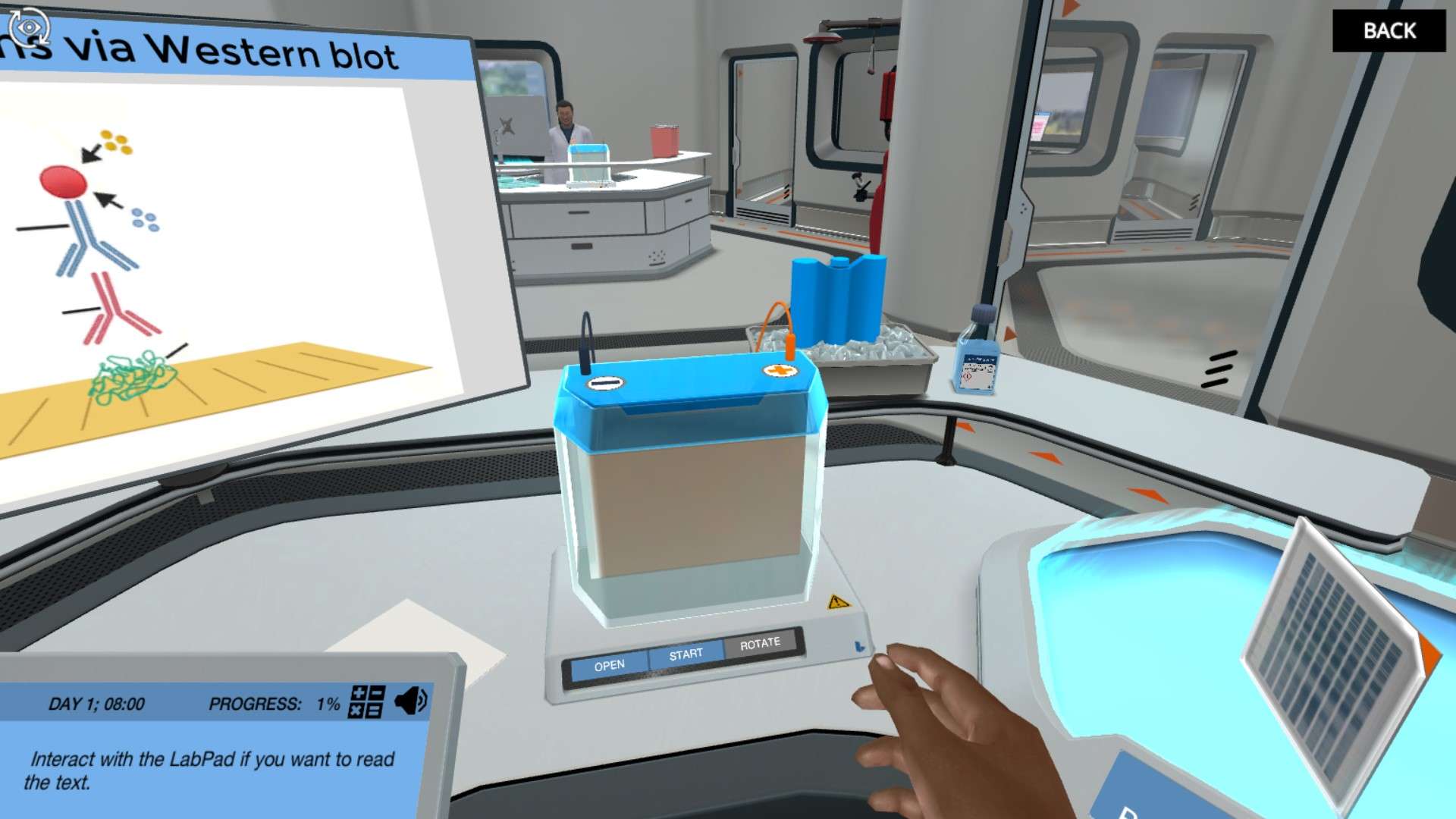Heading 1
Heading 2
Heading 3
Heading 4
Heading 5
Heading 6
Lorem ipsum dolor sit amet, consectetur adipiscing elit, sed do eiusmod tempor incididunt ut labore et dolore magna aliqua. Ut enim ad minim veniam, quis nostrud exercitation ullamco laboris nisi ut aliquip ex ea commodo consequat. Duis aute irure dolor in reprehenderit in voluptate velit esse cillum dolore eu fugiat nulla pariatur.
Block quote
Ordered list
- Item 1
- Item 2
- Item 3
Unordered list
- Item A
- Item B
- Item C
Bold text
Emphasis
Superscript
Subscript
About This Simulation
Join Dr. One and two colleagues on their mission to cure cancer. They are using Western blot to compare the level of p53 protein in cancerous and healthy control cells. Can you help Dr. One with the tricky membrane transfer step?
Learning Objectives
- Build a transfer stack with the correct orientation
- Set up a transfer tank to transfer protein from an SDS-PAGE gel to a membrane.
- Critique the quality of protein transfer using a removable protein-identifying stain.
About This Simulation
Lab Techniques
- Western blotting
Related Standards
- Support for laboratory skills at all levels
- No direct alignment
- Technical support for relevant Lab Investigations
- No direct alignment
- Generic support for relevant Lab Investigations
- No direct alignment
- Generic technical support for practical skill development
Learn More About This Simulation
Air bubbles are the enemy and if you are not careful you may cause a minor explosion! In this simulation you will learn how to set up and troubleshoot the transfer step of Western blot. Dr. One has already separated the proteins by size using gel electrophoresis. Before they can continue to use antibodies to detect the levels of p53 protein, the protein samples must be transferred from the gel to a membrane.
Building a stack
You will use electricity to transfer the proteins from the gel to the membrane. The gel and membrane must stay closely together during the whole procedure. To achieve this, you start by building the transfer stack. Be careful, as a mistake here could ruin your experiment! Luckily Dr. One is on hand to guide you.
Transferring the proteins
Once you have built the stack, you are ready to assemble the tank in which you will use electricity to move the proteins onto the membrane. As your colleagues Jenny and Mario will be able to tell you, even with the perfect stack, there is still the potential to cause a minor fire or other disaster at this point! Thankfully, the process is much quicker in the virtual lab as you do not need to wait for the transfer to complete.
Analyzing your results
Using antibodies to detect proteins is another lengthy process. Before handing your membrane over to Dr. One for this part of the Western blot experiment you want to make sure that you have been successful. You will use ponceau to stain all the proteins on the membrane so you can assess the quality of your transfer. Jenny and Mario have been working alongside you and need some help checking their membranes too. Can you find the best membranes for Dr. One to analyze?
For Science Programs Providing a Learning Advantage
Boost STEM Pass Rates
Boost Learning with Fun
75% of students show high engagement and improved grades with Labster
Discover Simulations That Match Your Syllabus
Easily bolster your learning objectives with relevant, interactive content
Place Students in the Shoes of Real Scientists
Practice a lab procedure or visualize theory through narrative-driven scenarios


FAQs
Find answers to frequently asked questions.
Heading 1
Heading 2
Heading 3
Heading 4
Heading 5
Heading 6
Lorem ipsum dolor sit amet, consectetur adipiscing elit, sed do eiusmod tempor incididunt ut labore et dolore magna aliqua. Ut enim ad minim veniam, quis nostrud exercitation ullamco laboris nisi ut aliquip ex ea commodo consequat. Duis aute irure dolor in reprehenderit in voluptate velit esse cillum dolore eu fugiat nulla pariatur.
Block quote
Ordered list
- Item 1
- Item 2
- Item 3
Unordered list
- Item A
- Item B
- Item C
Bold text
Emphasis
Superscript
Subscript
A Labster virtual lab is an interactive, multimedia assignment that students access right from their computers. Many Labster virtual labs prepare students for success in college by introducing foundational knowledge using multimedia visualizations that make it easier to understand complex concepts. Other Labster virtual labs prepare learners for careers in STEM labs by giving them realistic practice on lab techniques and procedures.
Labster’s virtual lab simulations are created by scientists and designed to maximize engagement and interactivity. Unlike watching a video or reading a textbook, Labster virtual labs are interactive. To make progress, students must think critically and solve a real-world problem. We believe that learning by doing makes STEM stick.
Yes, Labster is compatible with all major LMS (Learning Management Systems) including Blackboard, Canvas, D2L, Moodle, and many others. Students can access Labster like any other assignment. If your institution does not choose an LMS integration, students will log into Labster’s Course Manager once they have an account created. Your institution will decide which is the best access method.
Labster is available for purchase by instructors, faculty, and administrators at education institutions. Purchasing our starter package, Labster Explorer, can be done using a credit card if you are located in the USA, Canada, or Mexico. If you are outside of North America or are choosing a higher plan, please speak with a Labster sales representative. Compare plans.
Labster supports a wide range of STEM courses at the high school, college, and university level across fields in biology, chemistry, physics, and health sciences. You can identify topics for your courses by searching our Content Catalog.















